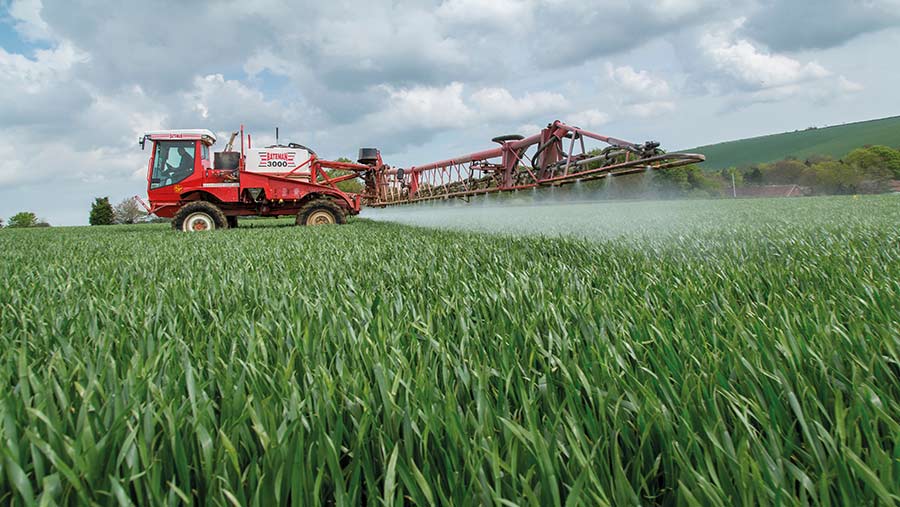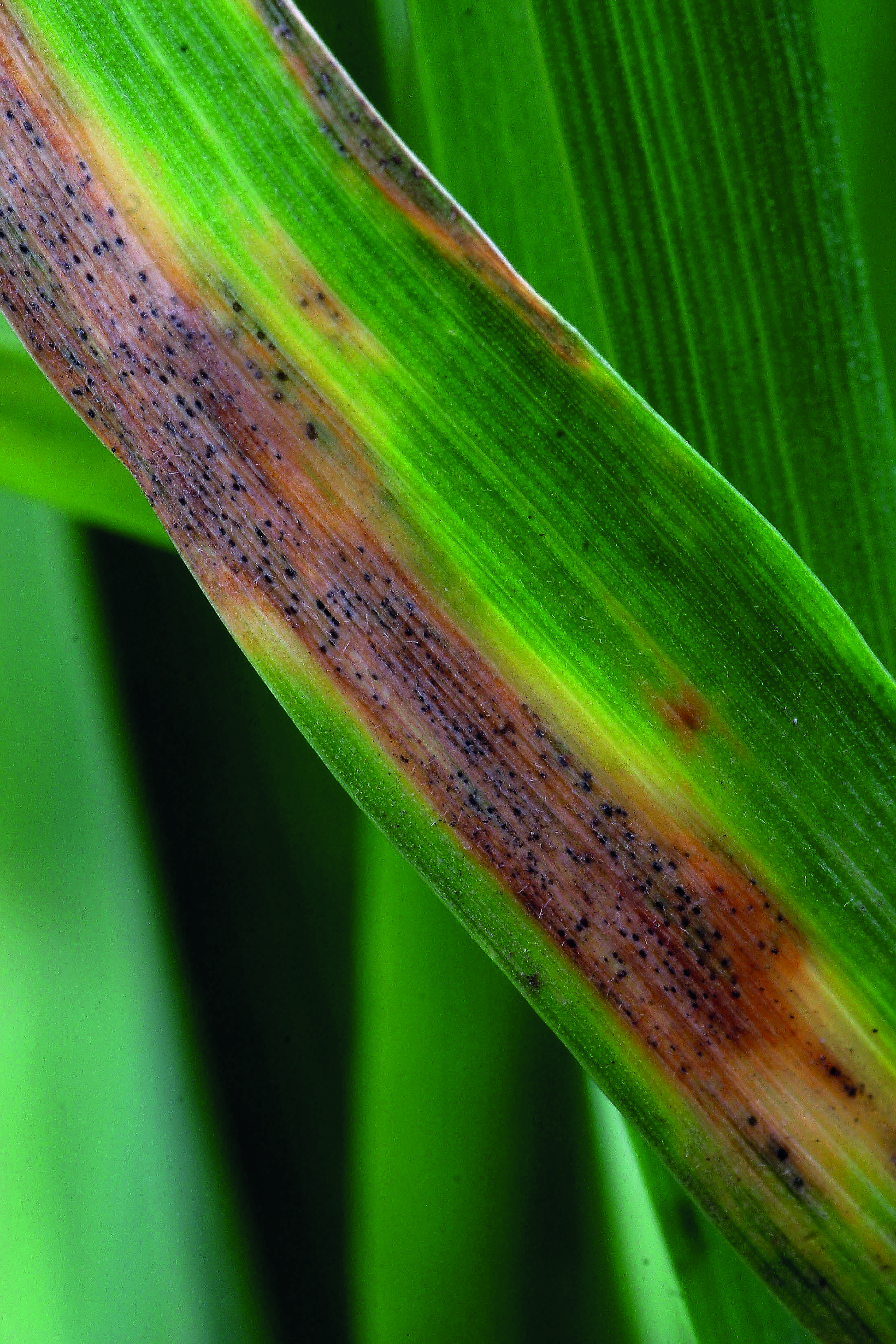Guide to tackling septoria disease in wheat
 © Gary Naylor
© Gary Naylor Septoria tritici is the most damaging foliar disease of UK wheat, causing yield losses that can range from about 30% to as much as 50% in high-pressure seasons.
Considered by most agronomists to be by far the biggest threat to UK cereal crops, septoria has come into even sharper focus as it has developed reduced sensitivity to key fungicides, affecting their performance in the field.
See also: What potato seed treatment changes mean for application
How it spreads
Septoria overwinters in a dormant state on crop debris, trash, grass hosts and volunteers.
Infection usually results from airborne spores moving into crops and landing on the leaves. This is followed by a 14- to 28-day latent period, when the fungus grows within the leaf but no symptoms are exhibited.
The latent period for septoria can vary in its length and it is affected by temperature – at higher temperatures, latent periods are shorter. In the UK, the usual lifecycle for septoria is 15-18 days.
Once septoria is in the crop, the ideal conditions for its growth are temperatures between 15-25C, together with moisture. Warm, wet springs are perfect, which is why higher rainfall areas tend to have more problems with the disease.
After this initial phase, it then spreads up the plants by physical contact between leaves and by rain splash.
Septoria risk factors
- Mild winters
- Wet conditions in spring
- Susceptible wheat varieties
- Early sowing
- High rainfall
Symptoms

© Blackthorn Arable
Septoria lesions, which are first evident in the autumn on the older leaves, are brown leaf spots containing very distinctive small black fruiting bodies, known as pycnidia.
This makes it easy to recognise in the field, with the disease usually being picked up before Christmas.
As septoria progresses, the lesions join up to cover large areas of the leaf, turning it brown. When its development is rapid, water-soaked lesions will be present.
Lesions that are adjacent to a newly emerged leaf allow the spores to transfer very readily, giving a higher risk of infection. Those that are 30-40cm below emerging leaves are a lower risk, especially in dry conditions.
Managing septoria
As septoria populations become less sensitive, the declining effectiveness of fungicides is placing more emphasis on the use of an integrated approach to reduce the risk of disease.
Early-sown (September) crops are infected quickly by septoria and the disease has more time to develop in the autumn in favourable conditions.
This means drilling date is particularly important with susceptible varieties and plays an important role in a high-pressure year.
Pushing the drilling date back into October is advised to reduce the crop’s exposure to inoculum, with work done by Adas showing that a four-week drilling delay significantly reduces the disease risk.
Alongside this, plant breeders are making good progress with introducing genetic resistance to septoria. Again, Adas work shows a clear effect of variety on disease, with resistant varieties having an impact on both disease level and yield.
While there is a range of scores for winter wheat varieties on the latest AHDB Recommended List, there are now two varieties with a rating of over 8.
These can be used strategically to plan sowing dates and spray programmes and reduce the farm’s exposure to the disease in wet years, although they are still likely to need spraying and most will show a good response to fungicides.
Spray timings
Spray timings have been developed to protect wheat leaves, so that infections are unable to really take hold. This is because the crucial final three leaves are at risk as soon as they emerge.
Application timing is essential for success, as changes in the pathogen’s sensitivity to fungicides mean that three weeks’ protection is now the maximum that some fungicides provide, even at robust rates.
That makes attention to detail more important than product choice, with agronomists agreeing that getting behind with spraying is to be avoided, and stressing that it’s better to be a day or two early than a day or two late.
Spray timings
- T0 – protects leaf four – GS 30 (or two to four weeks before the T1 spray)
- T1 – protects leaf three – GS 31-32
- T2 – protects leaf one (flag leaf) – GS 39
- T3 – protects the ear – GS 61-65
Fungicides
The septoria fungicide toolbox is limited to three main groups – the azoles, the SDHIs and multisites.
Two of these groups have already lost or will be losing key products, with multisite chlorothalonil already banned and epoxiconazole in a use-up period and will be banned in 2022.
Of those, the azoles have seen the biggest decline in performance due to reduced sensitivity, with their eradicant control dropping by over 60% since they were introduced.
Shifts in sensitivity to the SDHIs have also been seen, but in most field situations they are still giving good control.
Multisites, which have been in use for many years, remain unaffected and have a low risk of resistance. However, with chlorothalonil gone and mancozeb under threat, the only multisite that may be available to growers in the future is folpet.
Other chemistry, such as the morpholines, can have some effect on the disease, but are not active enough to be used as a key component of a septoria strategy. The strobilurins are ineffective against septoria, due to widespread resistance.
Multisite fungicides are a vital tool for septoria management, notes Adas cereal disease specialist Jonathan Blake, who adds that they should be the first product into the tank at both T1 and T2 when it comes to septoria and should also form the backbone of any resistance management strategy.
“Losing chlorothalonil has ripped a hole in septoria programmes,” he says. “But there are other multisites and they will give an economic return.
“Folpet may not be as effective as chlorothalonil was on septoria, but it does reduce pressure on high-risk chemistry and it won’t interfere with the curative activity of azoles. Growers need to adjust programmes accordingly.”
Programmes
The T0 spray does very little for septoria control and it is rare to see a benefit from it where this disease is concerned if the T1 and T2 sprays are applied correctly, he notes.
“For other diseases, the T0 is more important and offers some insurance. But with septoria, the T1 and T2 timings are the main ones.”
Bill Clark, technical director of Niab Tag, agrees and notes that there won’t be a yield response from a T0 in most years. “But it offers some help if you don’t get the T1 spray right, so it gets applied for the flexibility it brings.”
While most field situations will warrant the use of an SDHI at T2 in a three-way mix, the more difficult decisions about product choice come earlier in the season at T1, believes Mr Blake.
“The worst thing to do is to apply an SDHI where it is not needed, so try and keep two applications of SDHIs as the exception,” he says.
“When chlorothalonil was still available, an azole plus multisite mix at T1 was often adequate. That may need revisiting this year, especially where a T0 hasn’t been used and the weather is unsettled, or you’re growing a susceptible variety.”
Growers in the West with susceptible varieties were always more likely to see a benefit from including an SDHI at T1, while others did it for risk-management purposes, he accepts.
At T2, it’s often worth using all the firepower on offer, such as one of the best SDHI products with a high rate of azole.
The AHDB fungicide dose response work conducted in 2020 showed that SDHI/azole mixes such as Ascra and Revystar continued to give the highest level of septoria control, with newcomer Revystar performing strongly and much better than the SDHI component alone.
If septoria control needs topping up at T3, an azole will do the job, with prothioconazole and tebuconazole the main contenders.
Resistance management
All fungicide programmes used on wheat must adhere to the guidelines on resistance management. High-risk practices are thought to accelerate declines in sensitivity to both azole and SDHI fungicides.
To maintain the efficacy of SDHI fungicides against cereal pathogens, the following guidelines apply:
- Limit the number of applications to two SDHIs in one crop
- Always use SDHIs in mixtures with at least one fungicide from an alternative mode of action group that has comparable efficacy against the target pathogen
- Tank mixing two SDHI fungicides is not an anti-resistance strategy. In any tank mix, the SDHI should be applied in a balanced mixture with at least one other different fungicide
Actives
- Elatus Era – benzovindiflupyr + prothioconazole
- Ascra – bixafen + fluopyram + prothioconazole
- Revystar – fluxapyroxad + mefentrifluconazole

